In addition to all their other talents, the Mallarmé Chamber Players (MCP) know how to put on a party. It has become part of their tradition to end their season with a gala concert in a private home. This event is a fundraiser, but more than that it is also a reminder of the “chamber” aspect of chamber music. The impersonal quality of traditional concert venues is replaced by beautiful homes, gardens, fresh air, and a chance to meet the musicians afterward and share great food and champagne or other wines.
This year’s gala was graciously hosted by Jason and Anastasia Balius at their lovely wooded compound in the Forest Hills section of Durham. Approaching the imposing property, you were greeted at the gate by a collection of balloons, Mallarmé volunteers, and city employees insuring the exclusivity of the event. Before I left my home for this May 15 concert, I received several email weather advisories warning against severe thunderstorms, so I was interested to see how this garden party would proceed. It was a precarious walk from the front gate through active landscaping work, empty swimming pools, and dirt paths. We were directed to a side patio where narrow rows of folding chairs led up to a small canopy where the musicians would be performing.
The musical theme was “Russian Spring” although except for the nationalities of the composers and cellist Leonid Zilper, there wasn’t all that much distinctly Russian about the afternoon. The performers were a veritable United Nations of string players who also represented a wide diversity of musical positions within the state of North Carolina. Russian Zilper, a cellist with the North Carolina Symphony, was joined by his wife, violinist Hsiao-mei Ku, a member of the Ciompi Quartet and Associate Professor of Music at Duke University. The other violin chair was filled by Detroit native Richard Luby, Associate Professor of Music at UNC-Chapel Hill. The quartet was filled out by Israeli violist Yoram Youngerman, who is currently on the music faculty at East Carolina University. Those who are familiar with these artists – and most people present probably were – found it was interesting to see these musicians in a setting and configuration different from what we are used to.
The first work was a string trio by the relatively unknown Sergei Taneyev, who was greatly respected in his time by such giants as Tchaikovsky, Rachmaninov, and Scriabin. For this piece, Ku sat out and served in the crucial position of music monitor, which was no small task. It was quite windy and music stands were filled with extenders, clothes pins, and whatever it took to insure that the parts didn’t end up in the trees. This work was about as Russian as “Yankee Doodle Dandy.” Taneyev was known as a Viennese wannabe, and this trio is the epitome of his adherence to classical-period models. It is a pleasant, easy-on-the-ears work without any unique attributes. Surprisingly, the acoustics were remarkably sharp and resonant, which you would not expect from an outdoor concert.
Ku joined Youngerman for a splendid reading of Bohuslav Martinu’s rarely-heard Three Madrigals for Violin and Viola, written in 1947. Martinu is a master of string duos, and I had the pleasure of hearing his equally difficult and captivating duo for cello and violin at UNC-Greensboro’s Bernard Greenhouse Celebration last March. Ku and Youngerman gave a performance that ranks as one of the finest of this season. The work is filled with an almost manic rhythmic drive, double-stop trills, and exquisite string writing. I have no idea of the amount of preparation time these two artists invested, but they delivered the extremely difficult composition as if they were born to it. Mallarmé is known for coming up with wonderful gems that aren’t well known, and this shone as bright as anything that’s ever been presented.
We went from the little-known to a string quartet that has some of the most recognizable melodies ever written – although some may not know its origins. Alexander Borodin wrote his Second String Quartet in 1881 as a 20th-wedding-anniversary gift for his wife. The second and third movements have the most memorable themes, and many of them became popular through their use in the Broadway musical Kismet. Some songwriters even lifted entire melodies and used them as their own. The performance didn’t have quite the polish of an established quartet, but that’s to be expected, despite the individual excellence of each player. Nature took its part during the last movement as the wind began to pick up and the sky darkened. The timing was perfect: the rain began just as the audience lined up for the “gala” portion of the afternoon. Everyone huddled around a small sheltered area while the rains came down, and we had to console ourselves with cold champagne and crab cakes. Yes, it was quite a hardship. The only downside of the afternoon was that we didn’t get to see any of the interior of the historic home.












